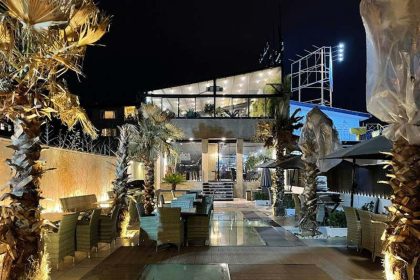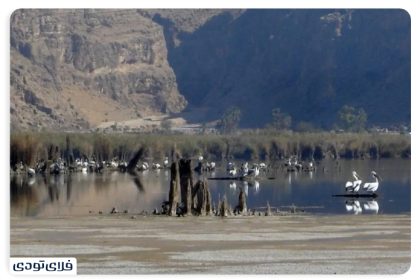The Iranian and German couple took a path in life fifty years ago, which now has many lovers and is a dream of many people; Become a permanent passenger on the roads!
A woman in a pink T-shirt is sitting on top of the towers of Arg Bam and staring at the greatness of this historical fortress. A photo that was circulated in the virtual space of Persian speakers many years ago, filled the eyes with a picture of the Bam Citadel before the earthquake, from a different view. But this photo was a key to find the woman sitting in the photo frame; Hoping to find more photos of Iran at that time. Searching in the miracle of the Internet is always accompanied by surprise, and this woman in a pink shirt is suddenly named Parveen, and her life fifty years ago draws one into a strange story of a different life in the distant past.
Now, it is not so strange to see people and couples who stop living in a fixed house and live permanently on the roads, even in Iran. Now even this euphoria of living in the moment is fading and other things are becoming popular. Of course, this liberation from its place and limitations has a long history and in the modern world, it was fashionable decades ago and it is still going on. Regardless of the possible critical view of this life situation, those older people who saddled a horse and galloped along this path, seemed to have more purity and were far from the conventional expressions of our time. Now imagine that an Iranian and a German couple in the 1950s traveled this route with their car to travel the world and experience the sights in the mornings and evenings that the working man in the city is deprived of seeing. “Pervin Daneshfar” and “Klaus Komus” were such people, with strange stories and memories from years spent in the known and unknown.
For Parvin and Klaus
Searching the dusty corners of the internet for historical photos, there is always something to discover. Sometimes a person comes to his senses and sees that dozens of pages with hundreds of stories and photos are open in front of him. The story of Parvin and Klaus was found on these pages five years ago, and pieces of the puzzle of their lives were put together from their blog. Searching for traces to talk with the world-traveling and different Iranian woman showed that Parveen and Klaus have not updated their blog and pages for more than 12 years, and it is probably impossible to find them anymore or ask others about their fate; The latter can also be said with some confidence. Condolence messages under their last blog post dated August 2012 indicate that Klaus is no longer a traveler in this world, leaving his companion Parvin alone after decades of travel and adventure. After these messages of condolences and a short reply from Parvin in 2013, there is no trace of them.
In the introduction section of their blog, Parvin and Klaus consider themselves to be from the Boomer generation, a generation full of babies from the time of the population explosion after the end of World War II. This is the only thread of their age. They wrote there that they do not have children and emphasized that “there are enough children on this planet”.
Parvin studied physics in Germany and Klaus studied engineering. According to their own account, the two met when Klaus was preparing a photo exhibition and Parveen arrived to buy Klaus’ best photo. Parveen asks him to send the photo to him and writes his name and address on a piece of paper with an eyebrow pencil and hands it to Klaus. Klaus remembers in his notes 40 years later that Parvin never paid him for that photo; But time has another story for them with that photo.
In a newspaper clipping of an unknown date, there is an article about Parvin and Klaus attached to a smiling photo of the two of them with their Benz truck, as follows:
Around the world in 80 days was not enough for Parvin and Klaus, and they planned to spend 10 years traveling around the world.

One of Parvin and Klaus’ four-wheeled houses
In this conversation, Klaus introduced himself and Parvin as “travel addicts”. Among his photos, you can see that this couple has spent their lives riding any attractive four-wheeler that is now the feed of Instagram and Pinterest photos; From classic Volkswagens to Benz minibuses, large and spacious caravans, ambulances converted into campers and even Benz trucks. Parvin and Klaus should be considered as the first contemporary pioneers of a path that many couples with similar circumstances are now taking in Iran and abroad.
However, the common roots of these pilgrims should also be considered. Klaus starts his writings from the time he met Parvin; Writings that were handwritten letters without an addressee; But sometimes carbon copies of these writings about their adventures and travels were also sent to their friends. The writings that Klaus collected years later in 2011 along with his photos to put on a blog that is available to everyone. Maybe if Instagram was available at that time, it would have led Parvin and Klaus to collect more likes and followers.
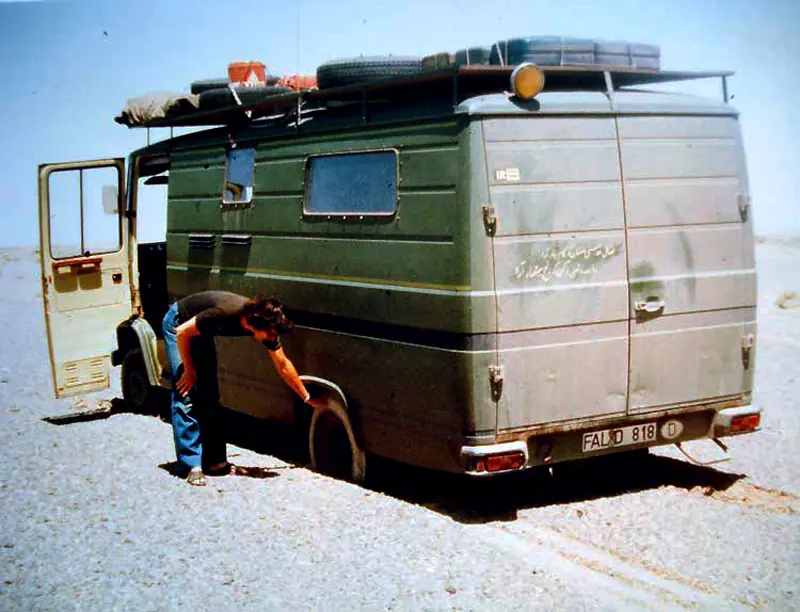
Klaus with the car with which they traveled to Iran
Seedlings of friendship in the fabric of Iranian carpet
A verse from Hafez’s Ghazal behind a dirt-covered Benz minibus in the middle of nowhere in the desert with a man checking the car’s tires was the second photo that was found after searching for the Arg Bam photographer. At the very beginning of seeing that photo, that dusty poem on the back of the minibus, which is official among the people of the road, announced a connection with the photographer and the owners of the photo:
Plant a sapling of friendship that will fill your heart with flour, cut down a tree of enmity that will cause countless suffering
The story started with a single photo of the citadel, and now it became more interesting as it progressed. A photo that was published by dozens of pages and news agencies with exciting headlines “unseen photo of the historical citadel”, but none of them knew the names of Parvin and Klaus and probably had no news of their story and presence.
But that photo has an interesting story in it, all of which Klaus explained in a blog post; A story that takes us more into the life of this different couple and accompanies them on their strange journey from Germany to Iran in the 1950s. Traveling around the world, the pleasure of which remained so much in the minds of Parvin and Klaus that years later they left home and life in Germany again and became permanent road travelers to carpet all the roads of the world with their presence.
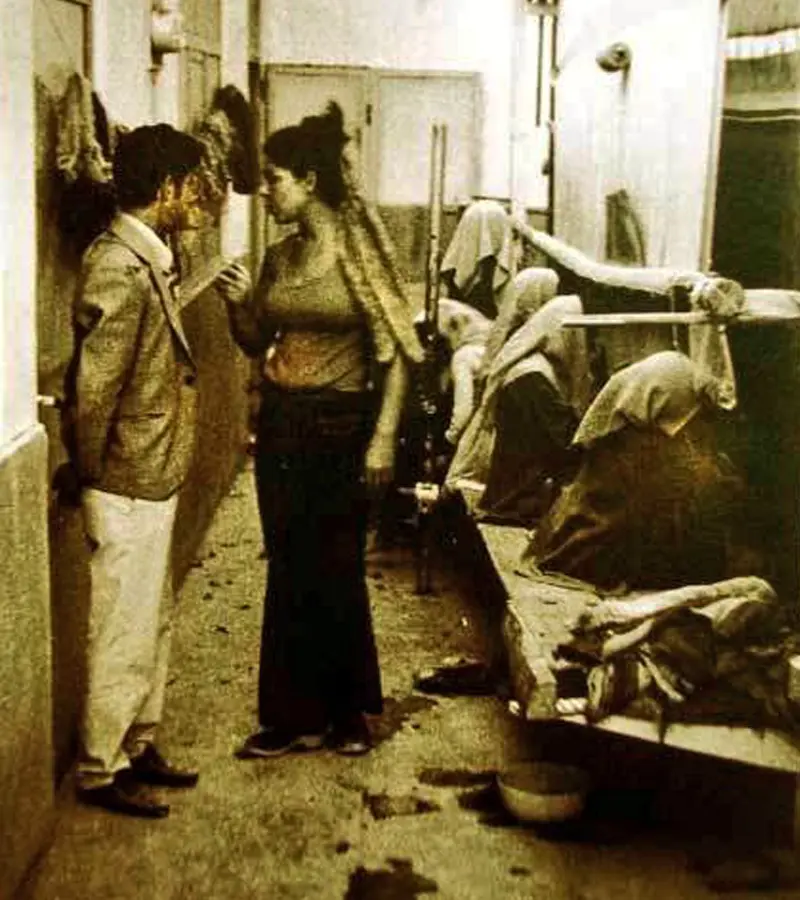
Parvin in the carpet weaving workshops of the 1950s
The carpet, this mysterious Iranian fabric was connected to a part of Parvin and Klaus’ life and became the key to their discovery 50 years later and miles away. The pattern of the Persian carpet is so charming that German Klaus never thought that he would be able to step on a work of art one day, and his pocket would not allow him to have even a piece of it for himself. But the first journey and trip to Iran, despite the fact that, apart from lack of money, he only got imagination and watching the carpets, he had somehow connected the fabric of his mind with the patterns of Kashan, Kerman, Isfahan and those carpet inscriptions. It was no longer possible to break away from the idea that they could load carpets in a minibus, take them to Germany, pocket money and travel more and more.
During my first trip to Iran, I spent hours in the markets, I was fascinated by the exotic carpets. This historical art, which Iran is famous for, fascinated me a lot. We couldn’t buy any rugs on the first trip because we had no money and I was too restless to fantasize about crazy adventures in faraway lands. But after returning from the first trip around the world, although bankrupt but very eager, we went to Iran again, borrowed money and bought carpets from Iran and sold them in Germany.
Klaus wrote these in his memoirs and quickly added that he and Parvin soon became skilled in this work and stopped looking for carpets with traditional patterns; They look around to find the most special ones:
We went for exotic carpets with a unique aesthetic. Sometimes I enjoyed not only the visual experience but also the touch of them. Big, thick and heavy carpets that could decorate a room in a wonderful way; I never even dreamed of owning a house where I could use one; But now I could buy them all and roll over them; This was wonderful.
Old Iranian carpets are like Bach and newer carpets are like Beethoven; This description was made by Klaus after his trouble with the enchantment of Iranian carpets.
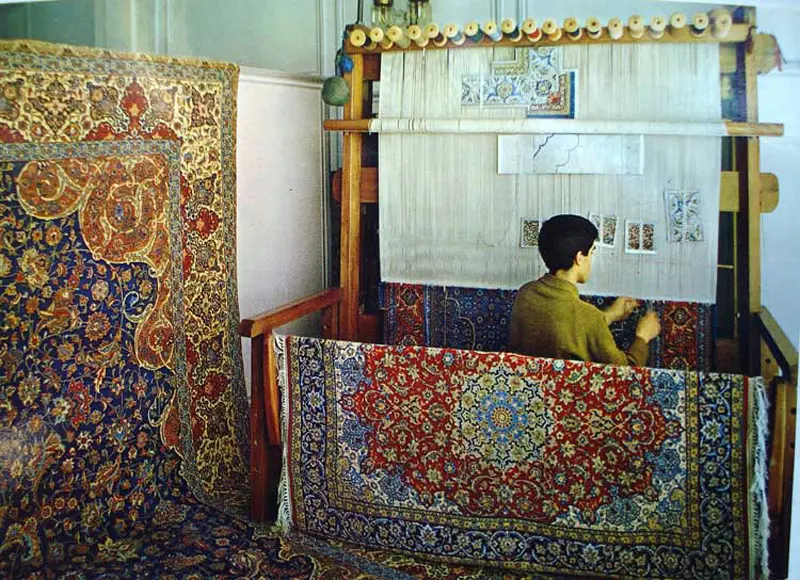
Klaus’ photo from the carpet workshop in the 1950s
But besides Parvin, Farsh and history, there were other things left in Klaus’s mind from Iran, which he mentions later in his writings. During his trip to France, after encountering his favorite fruit, velvety purple figs, he recorded a picture of it and wrote under it that of course his best experience of eating figs was in Iran, and for his 40th birthday, he received 40 figs from Parvin as a gift and had permission. is to eat all Elsewhere, he wrote about Iranian witchcraft; From cooking rice. The work that Klaus believed Iranians do in the best possible way is similar to witchcraft.
Except for the carpet, the report of their trip to Iran is the photos that Klaus and Parvin took from this trip. The same photos that years later become the key to discover the story of this adventurous couple. They gained detailed experience from their trips to Iran; For example, they noticed the cheap price of diesel in Iran; Therefore, by fitting a bigger tank and filling everything that could store diesel fuel, they traveled the five thousand kilometer route from Iran to Germany with only one refueling in Iran at a cost of 30 dollars; Of course, by enduring the constant smell of diesel throughout the trip!
The joy of life in the course of life
Parvin and Klaus, like road lovers, traveled to distant cities and unknown places many times with all kinds of four-wheeled vehicles that they prepared and equipped themselves. Even what we call the “lust of the cabin” today, happened to them at that time to go live in a wooden cabin in the middle of nowhere in America without electricity or facilities and enjoy the experience that there is nothing and no one in the distance. At the end of his Iran travelogue, which dates back to the 1950s, Klaus puts an end to an exciting chapter in their lives and writes:
We returned to Germany in the late 70s. We decided to play by the rules for a while; So we settled down, started something to make money, and of course we made more money selling our treasure rugs.
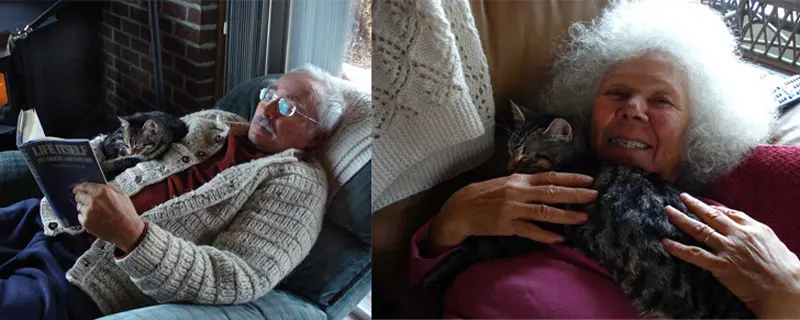
But the one who has tasted the pleasure of flowing on the roads will never give it up. Years later, Parvin and Klaus hit the road after Parvin retired and picked up their adventures where they left off, becoming world travelers again.
RCO NEWS














